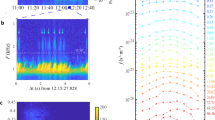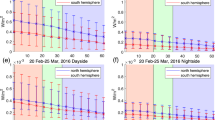Abstract
IT has been shown by Allcock1 and Pope2 that the diurnal occurrence of very-low-frequency emissions depends on geomagnetic latitude up to about 60°, with the maximum occurrence, measured in local time, increasing linearly with latitude. At higher latitudes, a band of noise (the ‘low emission band’), centred typically about 750 c/s and a few hundred c/s wide, is observed3 which does not appear to continue the pattern of lower latitude emissions4. However, a consistent picture is obtained if the time of peak occurrence is measured in a new coordinate system, apparently related to auroral occurrence and called ‘local mean auroral time’.
Similar content being viewed by others
Article PDF
References
Allcock, G. McK., Austral. J. Phys., 10, 286 (1957).
Pope, J. H., Nature, 185, 87 (1960).
Aarons, J., Gustafsson, G., and Egeland, A., Nature, 185, 148 (1960).
Ungstrup, Eigil, Roy. Tech. Univ. Denmark, Rep. No. 12 (Copenhagen).
Vegard, L., Phil. Mag., 23, 211 (1912).
Chamberlain, J. W., Physics of the Aurora and Airglow, 67 (Academic Press, New York and London, 1961).
Schneider, Otto, Contribucion del Instituto Antarctico Argentino, No. 55 (Buenos Aires, 1961).
Author information
Authors and Affiliations
Rights and permissions
About this article
Cite this article
BRICE, N., UNGSTRUT, E. Use of ‘local Mean Auroral Time’ for Very-Low-Frequency Emissions. Nature 198, 874 (1963). https://doi.org/10.1038/198874a0
Issue date:
DOI: https://doi.org/10.1038/198874a0
This article is cited by
-
A Ready Method for finding Eccentric Dipole Time
Nature (1963)



